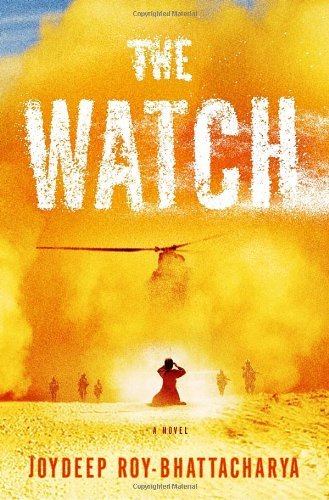25 Jul / The Watch by Joydeep Roy-Bhattacharya

 Before you begin The Watch, allow me to offer a few details about Joydeep Roy-Bhattacharya‘s writerly preparations you won’t find in the book. Although his ending “Acknowledgements” includes candid gratitude to numerous members of the U.S. military, the interview attached to the press materials sent with his title provides further specifics about the “innumerable heart-to-heart sessions” he spent with his “army mates,” the research he conducted about real-life events used in the book, and learning the logistics of military equipment, superior-subordinate relationships, even the halal slaughter of an animal, and more. Fiction this title may be, but its foundation is clearly built of non-fiction elements.
Before you begin The Watch, allow me to offer a few details about Joydeep Roy-Bhattacharya‘s writerly preparations you won’t find in the book. Although his ending “Acknowledgements” includes candid gratitude to numerous members of the U.S. military, the interview attached to the press materials sent with his title provides further specifics about the “innumerable heart-to-heart sessions” he spent with his “army mates,” the research he conducted about real-life events used in the book, and learning the logistics of military equipment, superior-subordinate relationships, even the halal slaughter of an animal, and more. Fiction this title may be, but its foundation is clearly built of non-fiction elements.
One more bit of background that will enrich your reading: spend a few minutes remembering the classic Greek myth of Antigone. No spoilers here: passages from Sophocles’ 5th-century B.C. tragedy of the same name open and end The Watch.
Ready? Here’s the seemingly simple story: A young Afghan woman arrives alone at a U.S. combat outpost in Kandahar Province demanding to bury her brother’s body in accordance with her Muslim beliefs, but the soldiers who have just survived a deadly attack are understandably suspicious of her intentions. In the stand-off that ensues, the young woman without legs sitting in a makeshift cart challenges the U.S. military on high alert watching behind a highly guarded fence. Seven distinct voices relay what happens: the dead man’s sister, the newly arrived Afghan Interpreter, and five U.S. soldiers of various ranks. Pieced together Rashomon-like, at the core of the narrative is the true identity of the Afghan woman: sister, survivor, victim, suicide bomber, spy, “diversionary tactic,” … or … ?
As the Americans argue over her fate, one fact is clear: ” … there’s absolutely nothing black and white about this situation: it’s all in grays.” Even on the ‘same side,’ the American reactions are diametrically opposed: from “That girl out there is officially my breaking point. I don’t want to be part of the SitRep that writes her off as collateral damage … It’s time to admit that our own leadership has ring-fenced us with lies,” to “Our job is to fight the enemy, clean up, and clear out. …We don’t do politics, and, beyond a certain point, we don’t get involved in these people’s lives.”
Roy-Bhattacharya uses his American characters to represent the murky spectrum of military viewpoints. His initial approach seems impersonal, titling his chapters with either mythic names or by military rank, from Lieutenant to Medic to Captain; in sharp contrast to that anonymity, each chapter reveals a unique individual, from the disillusioned classics scholar to the older career officer to a third-generation soldier questioning his patriotism. Amidst the careful attention given to multiple voices, the one notably missing story is that of Nizam’s brother; because the military, the damaged, the collaborator are all individually represented, in comparison, the voice of the ‘insurgent’ – the so-called enemy – seems unfairly silenced.
That said, this seven-pronged view of war proves intensely engaging and provokingly haunting. Choosing the audible option with seven distinct narrators offers even greater immediacy and is highly recommended. When that final page turns, regardless of ‘sides,’ all I can say is, “Mamas, don’t let you babies grow up to be soldiers …!”
Readers: Adult
Published: 2012
